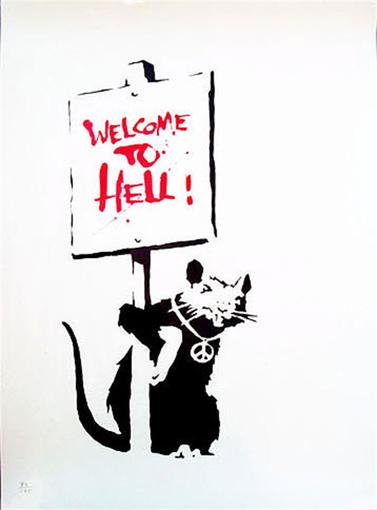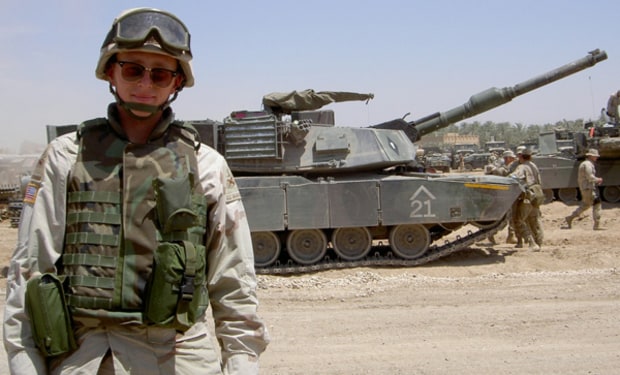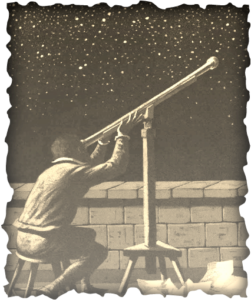We begin our descent.
In the first part of our seminar, we will consider four different images of Hell: War, Genocide, and two versions of existentialist Angst (one in a world where God is dead versus another in a world where He is alive).

I have two goals: I seek to acquaint you with some compelling experiences that we associate with Hell. Because this is a social science seminar, I also want to consider a complex term which, at first glance, doesn’t seem like it should be complex at all: description. What do we mean when we describe something? What does a good description look like? Why do people disagree over an exercise that seems so simple?
From this day onward, I expect you to devour all of the readings on this syllabus. In addition to the required books, please remember to bring copies of each of the assigned readings marked “Print” as well as hand-outs to class. You need to have the required readings in front of you so we can have a robust discussion.
1. Tuesday, January 14
Discussion Topic: Why is the idea of Hell a significant part of our daily lives? Why do we use the term so frequently?
Today, I outline my goals and the structure of this course. I will also conduct a class survey.
Assignment: On Thursday, we will begin our discussion of Roy Scranton’s excellent book, War Porn, as well as a short selection from the Catholic Catechism on “Hell.” As you read Scranton’s book, think about the following theme: According to Scranton, “war is hell because . . .” Then, write one brilliant introductory sentence which deals with this theme.
Please spend at least 20 minutes choosing the best sentence. Imagine that it is the introduction to a paragraph. Why would your sentence grab my attention?
Your sentence should be typed and double spaced. NOTE: You should consistently adhere to this rule throughout our course. I won’t be able to read anything that isn’t typed and double-spaced.
IMAGE ONE
THE WAR IN IRAQ I: “War is hell . . .”
2. Thursday, January 16
Discussion Topic: What is Hell? It depends on whom you ask. If we put the Catholic Church and Roy Scranton in the same room, will they get along?
-
-
-
- “Hell” according to the Catechism of the Catholic Church: PRINT AND READ
- Roy Scranton, War Porn Read only pp. 1-126.
- On PTSD: “War is Hell, and the Hell Rubs Off“
-
-
Today, we start familiarizing ourselves with the terrain of Hell. My personal guarantee: Everything we do as we move along will relate to later segments of the course.
As we begin, imagine yourself as a collector, picking up different visions of Hell and trying to discern what they are about. Scranton presents us with an image. So does the Catholic Church.
Assignment for Tuesday: Take the sentence you have generated for today’s class, m0dify it based on our discussion, and use it to introduce a brilliant (and complete) four sentence paragraph. Think hard about what a great introductory paragraph should do. Please spend lots of time making this paragraph the best one you can imagine writing. Note: Anyone can write a paragraph, but it is a big challenge to write a great one. I challenge you.
3. Tuesday, January 21
Discussion Topic:
-
-
-
- Finish reading Roy Scranton’s War Porn
- Roy Scranton, “Back to Baghdad: Life in the City of Doom,” Rolling Stone READ
-
-
 Come prepared to discuss the themes in the paragraph you have written for today.
Come prepared to discuss the themes in the paragraph you have written for today.
I am particularly interested in two issues: 1) What is war like in all of its manifestations? 2) If someone writes about war, how can he or she choose words to capture it in its fullness (remember the challenge of description).
4. Thursday, January 23
Discussion: Great Writing, Persuasive Criticism
George Orwell was one of the finest stylists in the English language. His works are deceptively easy to read. Most people cannot write like this. II want you to try.
Assignment: Please write a list of the five most important features of great writing. After each feature, write a one-sentence justification for why it is one of most important.
For the first half of this section, we will talk about what it means to write the introductory paragraph to a paper. What should it look like? What must it do?
Readings from George Orwell
-
-
-
-
- “Why I write” PRINT AND READ
- Famous facsimile (handout)
- Mystery Facsimile (handout)

- “Politics and the English Language” PRINT AND READ
- “Orwell gets an Apology” READ
- Bob Fischer and Nathan Nobis, “Why Writing Better will make you a Better Person”: PRINT AND READ
-
-
-
5. Tuesday, January 28
An excursus. From the Twenty-First Century to the Fourteenth Century and back. Our goal in today’s meeting is to understand how different depictions of Hell reflect the circumstances in which they are created.
Learning is as much about looking as about reading and listening.
We will hold class in the Special Collections Room of Hesburgh Library. Notre Dame is a powerhouse in Italian studies and has one of the finest collections of Dante’s Divine Comedy. Tracy Bergstrom, the library’s expert on this collection, will introduce us to visual depictions of Dante’s Inferno. Before we meet, read the following three Cantos closely. Also, read the notes so you know what’s going on. The better you understand these Cantos, the easier it will be for you to interpret the artistic depictions that we will see.
Canto I: PRINT AND READ
Background Notes: READ
Canto VI (a gluttonous study of Florentine politics): PRINT AND READ
Background Notes: READ
Canto XXXIV (Lucifer): PRINT AND READ
Background Notes: READ
READ: Is Hell Real? If it’s not, why would a smart guy like Dante say it is?
IMAGE TWO
GENOCIDE: “Driven into Hell”
6. Thursday, January 30
Discussion Topics: Francis Wade, Myanmar’s Enemy Within: Buddhist Violence and the Making of the Muslim Other. In this discussion section, I’d like us to start thinking about two issues:
-
-
-
- What is genocide? What should a writer do to describe genocide in all of its intensity?
- What does it mean to say that each of us has an “identity”? Are our identities fixed? What happens if we treat others as though their identities are fixed?
-
-
Read at least pp. 1-122.
For background, we will watch this video: “The Hidden Genocide: Al Jazeera investigates” HERE You do not have to watch it before class.
7. Tuesday, February 4
Discussion Topic:
Francis Wade, Myanmar’s Enemy Within: Buddhist Violence and the Making of the Muslim Other
Finish the book.
Is there any room for hope in Wade’s book? Or is it completely grim? What should our answer tell us about humanity?
8. Thursday, February 6
First Great Debate:
TOPIC: “We can always choose not to engage in evil actions. As the Cathechism tells us and as we’ve seen in books about the Iraq War and the Rohingya genocide, it’s a moral co-out to claim that any circumstance would prevent us from exercising this free choice.”
Debate structure: TBA
Note: This is a debate! Not a tea party. Be civil, but be determined to fight and win. Please leave your weapons at the door.
Prepare for your debate by identifying the structure of this particular exchange: Should NFL Prospects be required to play in college bowl games? READ PRO and CON Your debate should have exactly these features.
IMAGE THREE
EXISTENCE ITSELF: “LIFE IS HELL . . .”
9. Tuesday, February 11:
Existentialism, Version I: “A World Without God
I am cheating a bit with this class and the following image of Hell. Both of the readings are from the twentieth century. But they serve my purpose well enough to make my transgression worthwhile. Mea culpa. Although “existentialist” thinking is not in vogue at the moment, there are enough issues in the air today (e.g. global climate change; the spread of antibiotic-resistant bacteria; the possibility of a renewed mandatory military draft) to make me think this way of looking at the world will make a come-back.
For background purposes, you can find a very reader-friendly outline of “existentialism” HERE
Do not worry about the various types of existentialism; just get a sense for the general idea. In this case, we are looking at “existentialism for atheists.”
Discussion Topic: What does Jean-Paul Sartre think about life? Does he really believe it?
Jean-Paul Sartre, “The Wall” PRINT AND READ
10. Thursday, February 13:
Existentialism, Version II: “A World With God”
Flannery O’Connor, “The Lame Shall Enter First” PRINT AND READ
Topic: What is O’Connor’s view of human life? In her view, what would make life worth living?
Your first essay assignment is HERE
Be sure to read this assignment carefully and follow all of the instructions. Every word in both the assignment and the instructions counts.
You have one week to complete this assignment.
Please leave your technology at home. This includes electronic devices of any kind, such as laptops, i-Pads, i-Pads2, I-Phones 12, FBI trap-and-trace tools, Kindles, video cameras, or other personal digital devices.
This class is a no-tweet zone!
